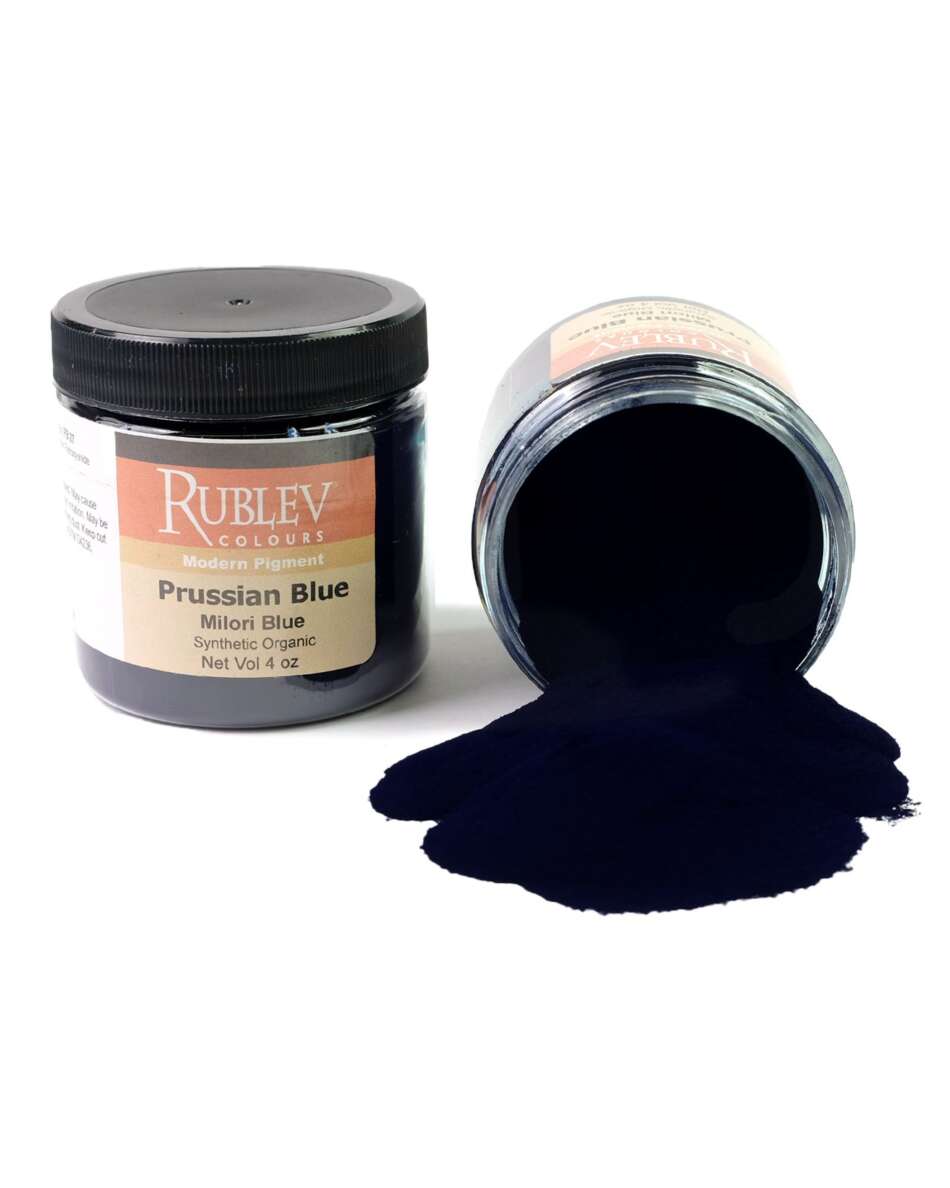Prussian Blue Pigment
Discovered in 1704 or 1705, Prussian blue is generally regarded as the first of the modern colors. In truth it is something of an anomaly, appearing well before the blossoming of chemistry as a science in the late 18th century.
Prussian Blue, like so many other innovations in color, was the result of a serendipitous accident. Prussian Blue is a synthetic organic pigment of a deep blue hue with a greenish tint.
| Pigment Names | |||||||
| Common Names: | English: Prussian blue French: bleu prussien, bleu de Prusse German: Preussisch Blau Italian: azzurro di Prussia Japanese: konjō, berensu Russian: берлинская лазаурь Spanish: azul de Prussia | ||||||
| Synonyms: | English: Berlin blue, iron blue, Milori blue, Paris blue, Turnbull blue, Chinese Blue, steel blue, ferric ferrocyanide German: Berlinerblau, Pariserblau, Turnbullsblau, Vossenblau Italian: azzurro di Berlin Spanish: azul de Berlin | ||||||
| Nomenclature: |
| ||||||
Origin and History
A Berlin-based color maker, Heinrich Diesbach, was working in the laboratory of the alchemist Johann Konrad Dippel, and in the course of preparing a red lake pigment, Diesbach asked Dippel for some potash (a potassium alkali).
Presumably, to economize, Diesbach requested a batch of potash contaminated with oils prepared from animal blood. It was a false economy, for his pigment turned out very pale. Attempting to concentrate it, he succeeded instead in turning it deep blue. He had no idea what had transpired but was astute enough to recognize the blue material as a potential pigment in its own right and was soon manufacturing it according to a jealously guarded recipe.
Iron blue was first mentioned in 1710 in a Latin text written by an unknown author, and its properties were described in a reference from 1726. It is said to have been discovered by the chemist and painter Diesbach in 1704, but other sources mention the chemist Johann Conrad Dippel, for whom Diesbach worked.
The first mention of its manufacture was by the English chemist John Woodward in 1726. Potash and ox blood were heated until they glowed and then subsequently boiled with rainwater. The "blood lye" obtained this way was heated with sulfate and alum. This produced a green intermediate product called "mountain green" or "chrysocolla green." The material was then washed and filtered. After a treatment with hydrochloric acid, the product eventually turned to a deep blue color. It was particularly valued for mixing light blues and appeared in skies by Watteau, Canaletto, and Gainsborough.
Source
Our Prussian Blue is made according to the process originated by the French colormaker, Milori & Company, Lyons, France, known as the Milori process.
Permanence and Compatibility
Prussian Blue is stable in weak acids but is decomposed by weak alkalis, so it is suitable for oil, encaustic (non-emulsified or saponified type), egg tempera, and watercolor, but not fresco and casein.
Oil Absorption and Grinding
Prussian Blue absorbs a moderately high amount of oil (40–50 grams of linseed oil per 100 grams of pigment) to make a paste.
Toxicity
Prussian Blue is not considered toxic; however, care should be taken in handling the dry powder pigment to avoid inhaling the dust.
For more information on handling pigments safely, please visit How to Safely Handle Art Materials and Pigments.
| Pigment Information | |
| Color: | Blue |
| Pigment Classification: | Synthetic inorganic |
| Colour Index: | Pigment Blue 27 (77510:1) |
| Chemical Name: | Ammonium iron(III) hexacyanoferrate(II) |
| Chemical Formula: | (NH4)Fe[Fe(CN)6]•xH2O |
| CAS No. | 25869-00-5 |
| EINECS No. | 247-304-1, 237-875-5 |
| Series No.: | 3 |
| ASTM Lightfastness | |
| Acrylic: | I |
| Oil: | I |
| Watercolor: | I |
| Physical Properties | |
| Particle Size (mean): | 0.4 micron |
| Density: | 1.80 g/cm3 |
| Bulking Value: | 14.2 lbs/gal |
| Refractive Index: | 1.56–1.662 |
| Oil Absorption: | 45 grams oil / 100 grams pigment |
| pH (10% Aqueous Slurry): | 3.0–5.0 |
| Heat Stability: | 130° C (266° F) for 30 minutes |
| Munsell Value: | 4.54PB 2.43/6.16 |
| Health and Safety | No acute or known chronic health hazards are associated with this product's anticipated use (most chemicals are thoroughly tested for chronic toxicity). Protect yourself against potentially unknown chronic hazards of this and other chemical products by keeping them out of your body. Do this by avoiding ingestion, excessive skin contact, inhaling spraying mists, and sanding dust and vapors from heating. Conforms to ASTM D-4236. |
For a detailed explanation of the terms in the table above, please visit Composition and Permanence.
| SKU | 417-17 |
|---|---|
| Brand | Rublev Colours |
| Vendor | Natural Pigments |
| Processing Time | Usually ships the next business day. |
| Color | Blue |
| Pigment Type | Inorganic, Synthetic |
Health & Safety: There are no acute or known chronic health hazards with the anticipated use of this product (most chemicals are not thoroughly tested for chronic toxicity). Protect yourself against potentially unknown chronic hazards of this and other chemical products by avoiding ingestion, excessive skin contact, and inhaling spraying mists, sanding dust, and concentrated vapors from heating. Contact us for further information or consult the SDS for more information. Conforms to ASTM D-4236.




